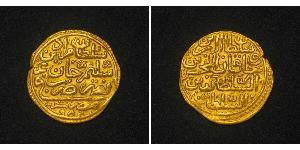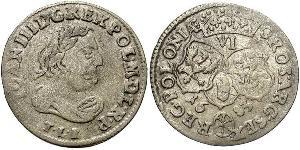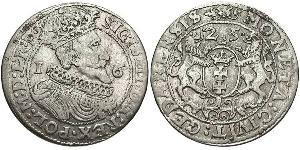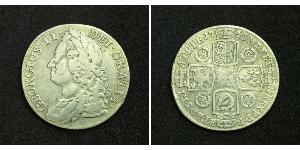(sold for $32.0)
1585, Regensburg (Free City). Silver ½ Batzen (2 Kreuzer) Coin. aXF!
Mint Year: 1585 Condition: About XF! Mint Place: Regensburg (Free City) Denomination: 2 Kreuzer (½ Batzen) References: KM-MB#164 ($70 in VF!). R! Diameter: 20mm Material: Silver Weight: 1.39gm
Obverse: Arms of Regensburg (crossed keys), flanked by date numerals ([15]8-5). Legend: + MON . NO . REIPVB . RATISBON : Reverse: Crowned double-headed eagle with cross-topped orb with kreuzer value (2) at chest. Legend: . RVDOLPH II . IMP . AVG . PFD .
Regensburg is a city in Bavaria, Germany, located at the confluence of the Danube and Regen rivers, at the northernmost bend in the Danube. To the east lies the Bavarian Forest.
The first settlements in Regensburg date to the Stone Age. The Celtic name Radasbona was the oldest name given to a settlement near the present city. Around AD 90 the Romans built a fort there.
In 179, the Roman fort Castra Regina ("fortress by the river Regen") was built for Legio III Italica during the reign of Emperor Marcus Aurelius. It was an important camp on the most northern point of the Danube: it corresponds to what is today the core of Regensburg's Altstadt ("Old City") east of the Obere and Untere Bachgasse and West of the Schwanenplatz. It is believed that even in late Roman times it was the seat of a bishop, and St Boniface re-established the Bishopric of Regensburg in 739.
From the early 6th century, Regensburg was the seat of the Agilolfing ruling family. From about 530 to the first half of the 13th century, it was the capital of Bavaria. Regensburg remained an important city during the reign of Charlemagne. In 792, Regensburg hosted the ecclesiatical section of Charlemagne's General Assembly. The bishops in council condemned the heresy of Adoptionism taught by the Spanish bishops, Elipandus of Toledo and Felix of Urgel. After the partition of the Carolingian Empire, the city became the seat of the Eastern Frankish ruler, Louis II the German in 843. About two years later, in 845, fourteen Bohemian princes came to Regensburg to receive baptism there. This was the starting point of Christianization of the Czech people, and the diocese of Regensburg became the mother diocese of Prague. These events had a wide impact on the cultural history of the Czech lands, as they were consequently incorporated into the Roman Catholic and not into the Slavic-Orthodox world. The fact is well remembered, and a memorial plate at St John's Church (the alleged place of the baptism) was unveiled a few years ago, commemorating the incident in the Czech and German languages.
In 1096, on the way to the First Crusade, Peter the Hermit led a mob of Crusaders who attempted to force the mass conversion of the Jews of Regensburg and killed all those who resisted.
In 1135–1146 a bridge across the Danube, the Stone Bridge, was built at Regensburg. This bridge opened major international trade routes between Northern Europe and Venice, and this started Regensburg's golden age as a city of wealthy trading families. Regensburg became the cultural centre of southern Germany and was celebrated for its gold work and fabrics.
In 1245 Regensburg became a Free Imperial City and was a trade centre before the shifting of trade routes in the late Middle Ages. At the end of the 15th century Regensburg became part of the Duchy of Bavaria in 1486, but its independence was restored by the Holy Roman Emperor in 1496. The city adopted the Protestant Reformation in 1542, and its Town Council remained entirely Lutheran. From 1663 to 1806, the city was the permanent seat of the Imperial Diet of the Holy Roman Empire which became known as the Perpetual Diet of Regensburg. Thus Regensburg was one of the central towns of the Empire, attracting visitors in large numbers.
A minority of the population remained Roman Catholic and Roman Catholics were denied civil rights ("Bürgerrecht"). The town of Regensburg must not be confused with the Bishopric of Regensburg. Although the Imperial city had adopted the Reformation, the town remained the seat of a Roman Catholic bishop and several abbeys. Three of the latter, St. Emmeram, Niedermünster and Obermünster, were estates of their own within the Holy Roman Empire, meaning that they were granted a seat and a vote at the Imperial Diet (Reichstag). So there was the unique situation that the town of Regensburg comprised five independent "states" (in terms of the Holy Roman Empire): the Protestant city itself, the Roman Catholic bishopric and the three monasteries mentioned above.
In 1803 the city lost its status as a free city following its incorporation into the Principality of Regensburg. It was handed over to the Archbishop of Mainz and Archchancellor of the Holy Roman Empire Carl von Dalberg in compensation for Mainz, which had become French under the terms of the Treaty of Lunéville in 1801. The archbishopric of Mainz was formally transferred to Regensburg. Dalberg united the bishopric, the monsteries and the town itself, making up the Principality of Regensburg (Fürstentum Regensburg). Dalberg strictly modernised public life. Most importantly he awarded equal rights to Protestants and Roman Catholics alike. In 1810 Dalberg ceded Regensburg to the Kingdom of Bavaria, he himself being compensated by the towns of Fulda and Hanau being given to him under the title of "Grand Duke of Frankfurt".
Between April 19 and April 23, 1809, Regensburg was the scene of the Battle of Ratisbon between forces commanded by Baron de Coutaud (the 65th Ligne) and retreating Austrian forces. It was eventually overrun after supplies and ammunition ran out. The city suffered severe damage during the fight with about 150 houses being burnt and others being looted.
Only 1$ shipping for each additional item purchased!

|
Posted by:
anonymous 2017-01-13 |
1 Rupee British Empire (1497 - 1949) Silver
group has 11 coins / 10 prices
⇑















-300-150-qGsKX9ISubMAAAFaDA5MgKnU.jpg)







